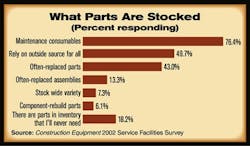Rod Sutton, Editor in Chief
Service facilities represent a major fixed overhead expense for fleet managers. For some, it's an expense they would eliminate if a distributor/independent service provider could perform to their standards. For others, it's an integral part of the fleet setup.
In both instances, having the right facilities for the fleet means providing efficient, economical and effective service. Fifteen years ago, Construction Equipment first asked fleet managers to describe their maintenance facilities in an effort to benchmark facilities by fleet size, measured in fleet replacement value. On this and following pages, we'll update those benchmarks.
Indoor square footage for maintenance shops averages a bit more than 18,000 square feet for the industry, with the smaller fleets around 4,000 square feet and the larger fleets about 54,000 square feet.
Of course, these are averages. Individual shops will vary in size and by the types of work done in them. But for fleet managers, these numbers provide a benchmark from which to judge their shops with others.
For our research, we were able to garner detailed responses from more than 700 equipment managers of all sizes of fleets. On this page are basic stats on how service facilities measure up. Turn to the subsequent pages for a more detailed look at facilities by fleet replacement size.
Facility Facts (by fleet replacement value) | | | All Fleets | Less than $500,000 | $500,000 to $1 million | $1 million to $5 million | $5 million to $10 million | More than $10 million |
|---|
| Source: Construction Equipment 2002 Service Facilities Survey |
| Basic facility descriptions track upward as fleet replacement value increases. And this is rightly so, as the sheer number of pieces of equipment increases. For all fleets, 83 percent do their maintenance out of only one location. By fleet size, that ranges from 97 percent of smaller fleets to 50 percent of the largest fleets. |
| Number of permanent locations | 1.4 | 1.1 | 1.2 | 1.3 | 1.9 | 2.7 |
| Square feet indoors | 18,192 | 4,046 | 8,996 | 26,766 | 21,812 | 53,868 |
| Service bays, main location | 3.9 | 2.3 | 2.7 | 4 | 5.8 | 9.2 |
| Service bays, secondary locations | 2.8 | 1.9 | 2.4 | 2.5 | 2.8 | 4.3 |
In-house vs. Outsourced (number of trucks/percent outsourced, by fleet replacement value) | | | All Fleets | Less than $500,000 | $500,000 to $1 million | $1 million to $5 million | $5 million to $10 million | More than $10 million |
|---|
| Source: Construction Equipment 2002 Service Facilities Survey |
| Managers will often balance their in-house services with outside help. In addition to brick-and-mortar facilities, most fleets have mobile service equipment. In order to be cost-effective, managers also look outside for maintenance service. Even the largest fleets outsource some of their service requirements. |
| Mechanics trucks | 2.6 | 1.3 | 1.6 | 1.8 | 3.3 | 8.3 |
| Percent field repairs outsourced | 36.3% | 45.7% | 39.9% | 31.9% | 26.9% | 29.5% |
| Lube/PM trucks | 1.7 | 1.2 | 1.6 | 1.6 | 1.5 | 2.4 |
| Percent PM outsourced | 26.4% | 35.9% | 27.0% | 22.4% | 21.0% | 17.7% |
| Fuel trucks | 6.3 | 1.6 | 1.7 | 2.1 | 13.7 | 24.2 |
| Percent fueling outsourced | 42.5% | 50.8% | 44.0% | 37.8% | 36.0% | 38.6% |
Benchmarks for Fleets: Less Than $500,000
Service Personnel (number of each type) | | Source: Construction Equipment 2002 Service Facilities Survey |
| Small fleets are lean on personnel simply because there are fewer machines to service. In fact, among fleets of this size, 68 percent say they don't have any parts people, and 26 percent say they don't have any shop mechanics. In many instances, a single person wears all the hats in small fleets. |
| Field mechanics | 1.6 |
| Mechanic helpers | 1.5 |
| Shop mechanics | 1.4 |
| Welders/fabricators | 1.4 |
| Parts people | 1.3 |




















